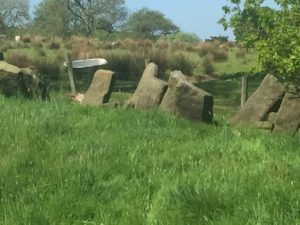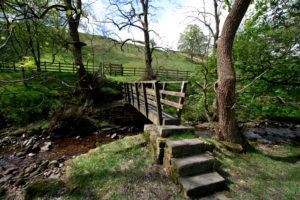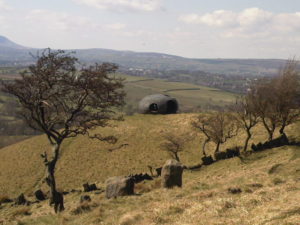A good group of people gathered at Wycoller car park for a splendid guided walk by our Chairman David Taylor. We examined the vaccaries (or medieval cattle ranches) in the area that had been researched by the group many years ago.
It was a beautiful day and many people saw aspects of Wycoller that they had not known about before. David explained the unusual nature of the tomb stone like vaccary walls and their purpose. The history behind these aspects of agricultural and farming practices was also outlined and the factors in their demise.

Vaccary walls at Wycoller
We examined the Clam, Clapper and Packhorse Bridges although the true history of the Clam bridge is apparently up for debate. After crossing the Pack horse bridge we examined some of the vernacular buildings in the hamlet amongst them Piersonson’s House which has “wuzzing holes” in the door jamb.

Footbridge at Turnhole, Wycoller Attribution Mark Anderson
Apparently the population of Wycoller rose in the 18th and 19th Centuries to around 350, many people were involved in the booming woollen industry. When the wool was washed it was treated to an early ‘spin dry’ process by putting the wet wool in a basket and the basket on a stick which was then inserted into the wuzzin hole and then spun round. Perhaps best not to get too near this process as wool was also – for various reasons – soaked in human urine! Woollen cloth was stretched out on hooks in the Tenter fields to dry. One such field can be seen above the pack horse bridge leading up to the Haworth road. As the woollen industry declined so did the population of the hamlet and it
is now around a hundred inhabitants many of who are concerned with the land again. It is thought that thirty five dwellings have disppeared.
And did you know fairies don’t only live at the bottom of the garden? On our return journey we spied Fairy doors in some of the trees around Wycoller and the road back to the car park. Some people proceeded to the Old Rock Cafe to enjoy a jolly lunch which rounded off a good walk.

Atom Panopticon set in the Wycoller Landscape. Attribution: markbelshaw